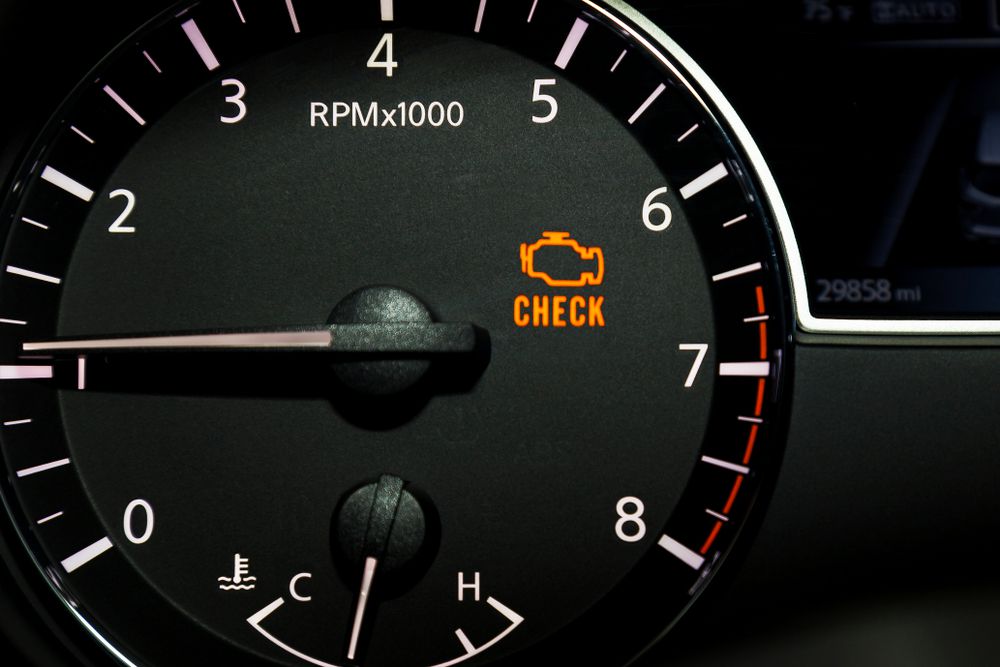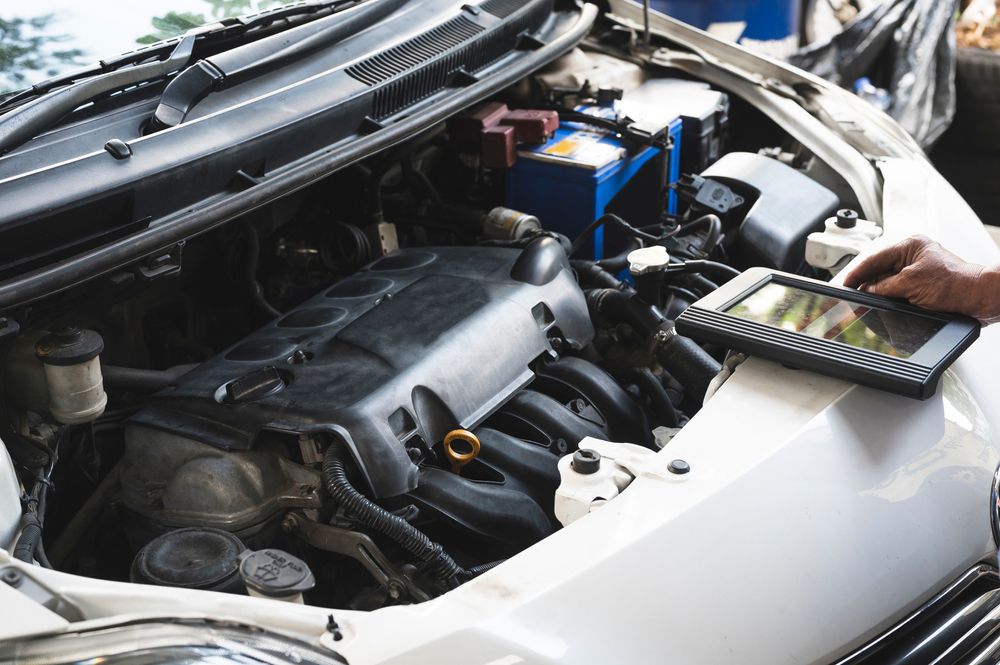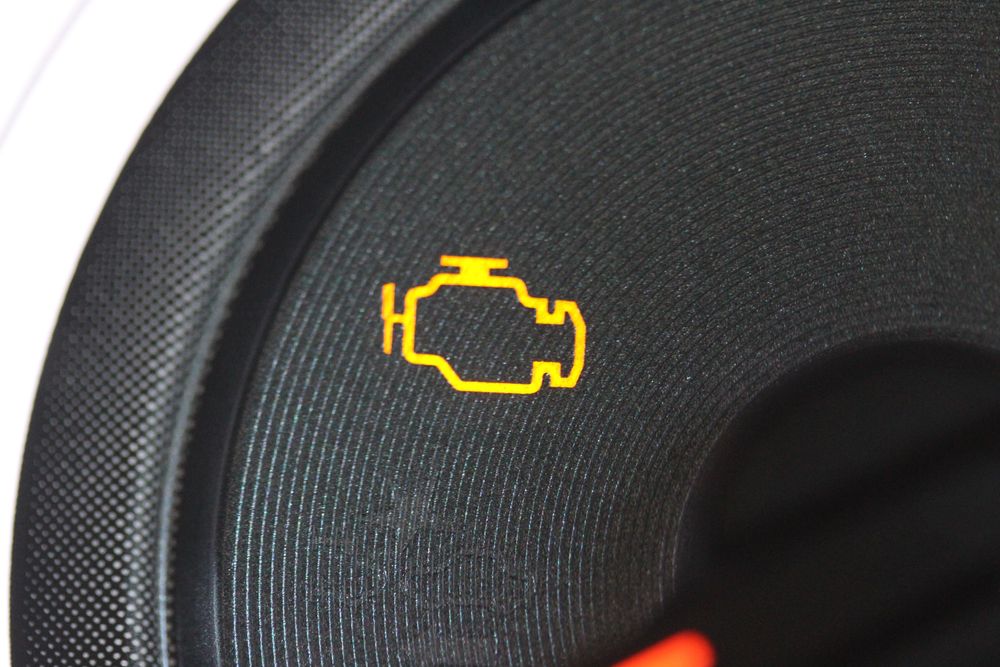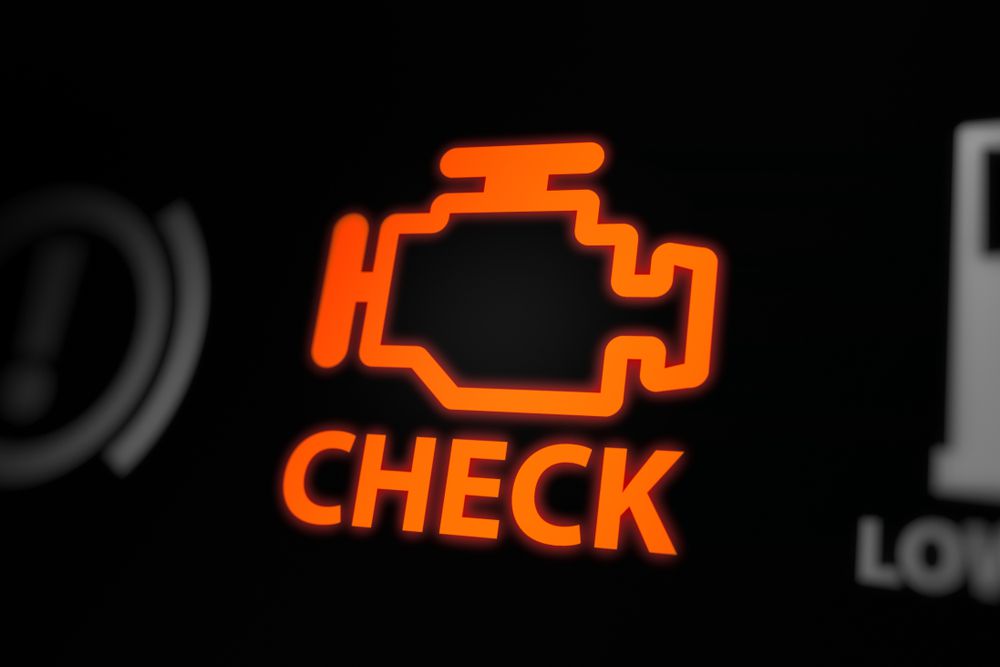If something has recently triggered your car's check engine light, but you don't notice anything wrong, you're probably wondering how long can you drive with service light on.
Depending on what caused the check light to engage in the first place, you may be able to drive for quite some time. However, since you likely won't know what's causing the problem, it's always best to have your vehicle serviced as soon as possible.
In this article, we'll quickly explain everything you need to know about your car's check engine light and dive into some of the most dangerous and least dangerous reasons why it may have turned on.
 Engine check engine light
Engine check engine light
Can I Drive My Car with the Check Engine Light On?
If your check engine light is on, it means your car's engine is having a problem.
Yes, you can drive your car with the check engine light on, but it should be avoided if possible.
The light could signal a serious problem and that your car is about to break down, or it could be a minor problem like a loose gas cap.
If you're driving with the check engine light on, you should take your car to a mechanic as soon as possible to have it checked with a scanner.
You can also buy your own OBD2 code reader relatively inexpensively to do your own troubleshooting.
Amazon has a multitude of OBD2 scanners at affordable prices like this one here (paid link).
Ignoring the check engine light could cause your car to break down or lead to bigger problems down the road.
Is It Safe to Drive with a Check Engine Light On?
Although your car's check engine light may have turned on due to a small, relatively insignificant problem, it's not safe to continue driving while your engine is at risk.
Ignoring the light could lead to further damage to the engine, which could eventually cause the vehicle to break down completely.
If you get a Reduced Engine Power warning light on your dashboard or notice a loss of power you should get your vehicle to a mechanic as soon as possible.
Why is My Engine Light On but Nothing Seems Wrong?
If your check engine light is on, but your car is running fine, there are a few potential reasons for this.
The most likely reason is that the check engine light is a false alarm.
This can happen if your gas cap is loose or if your car's computer needs to be reset.
Another possibility is that the check engine light is on because your car is due for an oil change or other routine maintenance.
The best way to figure out why your check engine light is on is to take your car to a mechanic and have them run a diagnostic test.
When Should I Be Worried About a Check Engine Light?
You should always be worried when your check engine light is on, but some reasons for the light being triggered are more serious than others.
If your check engine light is flashing, your car's engine is in serious trouble, and you should pull over and turn off the engine as soon as possible.
How Long Can You Drive with a Flashing Check Engine Light?
Driving with a flashing check engine light can damage your engine, so you should pull over, turn off the engine as soon as possible, talk to a mechanic and get their advice on if you can drive the vehicle to the shop or if you should get the vehicle towed.
Sometimes a vehicle will go into "Reduced Engine Power Mode", in which the vehicles Reduced Engine Power light will also light up and the vehicle will go into limp mode, greatly reducing the vehicles performance. In this case, it's also important to get your vehicle to a mechanic as soon as possible.
Is a Solid Check Engine Light Serious?
A solid check engine light is not necessarily serious, but it indicates a problem with the vehicle.
Compared to a flashing check engine light, it's usually triggered by a small maintenance problem rather than a mechanical breakdown.
What to Do When a Check Engine Light Comes On?
Don't panic if the check engine light comes on in your vehicle.
The problem with your engine is probably not serious, and it is relatively inexpensive or even free to get the trouble code read.
When the check engine light comes on you can get it checked in a variety of ways:
First, a mechanic can perform a diagnostic check and identify the problem.
Alternatively, you can take your vehicle to an auto parts store like AutoZone or NAPA Auto Parts and ask them to run the test.
Buy your own OBD code reader and troubleshoot the problem yourself.
If it's something simple, like an oil change, you can probably take care of it yourself. However, if it's more complex, take your vehicle directly to a mechanic.
How Much is a Check Engine Light Test?
Although you'll have to pay to repair an engine problem, most auto parts stores keep OBD-II scanners in stock and will check your engine light free of charge.
However, if you take it to a mechanic, they may charge for work, so we recommend sticking with AutoZone, NAPA Auto Parts, or another chain store.
 OBD test by a mechanic
OBD test by a mechanic
How Long Can You Drive with a Check Engine Oil Light On?
If your vehicle issues a solid check engine oil light, you should ideally get it serviced as soon as possible. However, if you cannot get it to the mechanic or change your oil, you can generally drive for around 500 miles before the light starts to flash.
Once your vehicle's check engine oil light starts flashing, get your oil changed immediately. Leaving it any longer could cause the engine to seize up and lead to serious structural damage.
 Yellow check engine light
Yellow check engine light
What Does a Yellow Check Engine Light Mean?
On most models, a yellow check engine light is a simple warning, indicating that you should have the problem investigated by a mechanic. However, it is a less-serious warning meant to act as a caution.
What Does an Orange Check Engine Light Mean?
Depending on the make and model of your vehicle, an orange check engine light indicates a more serious problem. You should stop driving and have your vehicle towed to a mechanic as soon as possible.
 Orange check engine light
Orange check engine light
What is the Most Common Cause of a Check Engine Light?
Your vehicle's check engine light may come on for various reasons such as:
1. Bad Catalytic Converter
The catalytic converter is responsible for converting harmful emissions into harmless gases before they exit the vehicle through the exhaust system. When it begins to fail, it will cause the check engine light to come on.
2. Bad Spark Plugs
Spark plugs are responsible for igniting the air/fuel mixture in the engine's cylinders. If they are worn out or fouled, it will cause the engine to misfire, and the check engine light will come on. Likewise, if your engine refuses to start, it could be due to a problem with the spark plugs.
3. Bad Mass Air Flow Sensors
The mass air flow sensor measures the amount of air entering the engine.
The engine control unit then uses this information to calculate the correct air/fuel mixture.
If the sensor is dirty or faulty, it will cause the engine to run lean or rich, and the check engine light will come on.
4. Bad Oxygen Sensors
The oxygen sensor is responsible for monitoring the amount of oxygen in the exhaust.
If it senses too little oxygen, it will adjust the air/fuel mixture to make the engine run richer, triggering the check engine light.
5. Bad Ignition Coil
The ignition coil is responsible for providing the spark that ignites the air/fuel mixture in the cylinders.
If it is not working properly, the engine will run poorly, and the check engine light will come on.
How Serious is an Engine Misfire?
Misfiring occurs when the air/fuel mixture in the engine's cylinders is not detonating properly.
Misfires are caused by various factors, including spark plug problems, compression problems, or fuel delivery issues.
When an engine misfires, it is not operating at its full potential, leading to engine damage, increased emissions, and decreased fuel efficiency.
How Long Does the Check Engine Light Stay on After a Loose Gas Cap?
If your vehicle's check engine light came on after you failed to tighten the gas cap, it should reset within just a few minutes.
If not, double-check that you've fully tightened the cap and continue driving.
If the light refuses to disengage, you can take your car to an auto parts store and ask them to reset the code.
Can a Check Engine Light Turn Itself Off?
Yes, depending on what caused the light to engage in the first place, a check engine light can turn itself off if the problem is resolved.
For example, the warning light should disengage within a few minutes after properly tightening a loose gas cap.
How Far Do You Have to Drive to Reset the Check Engine Light?
Depending on the make and model of your car, you'll have to drive between 25 and 100 miles at a range of speeds to reset the check engine light.
Your car's sensors need enough information to determine that the cause of the problem is gone.
How Much Does it Cost to Get Your Check Engine Light Fixed?
It's hard to predict the exact cost of fixing a check engine light problem because it depends on what caused the light to activate in the first place.
The cost could be as inexpensive as $30 to buy a new gas cap to over $1000 if you need a new catalytic converter.
Tip for Driving with a Check Engine Light On?
Although the best thing to do is to take your vehicle to a mechanic, follow these tips to help protect your engine while you continue to drive:
Driving more carefully reduces the engine's stress and helps it last longer until you can make it to the mechanic.
Conclusion
It is risky to drive your vehicle for any time without knowing what triggered it. If the light is yellow, it may signify a non-serious problem, meaning you can drive for a long time, or if it's orange, it could mean you have a serious problem that you should get checked by a mechanic as soon as possible. A flashing light means you have a serious problem and should pull over ASAP.
Frequently Asked Questions
What Do the Other Lights On Your Dash Mean?
The other lights on your dashboard have different purposes.
The oil light comes on when there isn't enough oil pressure in the engine.
The battery light comes on when there is an issue with the charging system.
The brake light comes on when the parking brake is engaged.
What Does the Maintenance Required Light Mean?
The maintenance required light is different than the check engine light.
The maintenance required light comes on when the car's computer has determined that it's time for regularly scheduled maintenance.
This light is usually reset after an oil change or routine maintenance.
How Far Can You Drive with the Gas Light On?
The answer depends on the vehicle. Most cars can travel at least 50 miles after the gas light comes on. So it's best to fill up the tank as soon as possible to avoid running out of gas.
What Does the Battery Light Mean?
Your vehicle's computer will engage the battery light if there is an issue with the charging system.
This could be caused by a problem with the alternator, voltage regulator, serpentine belt, or the battery itself.
What Does the Tire Pressure Light Mean?
The tire pressure light comes on when one or more tires are low on air. A slow leak could cause this in the tire or result from a nail or other object puncturing the tire.